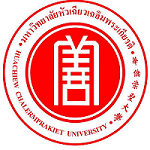Please use this identifier to cite or link to this item:
https://has.hcu.ac.th/jspui/handle/123456789/4832Full metadata record
| DC Field | Value | Language |
|---|---|---|
| dc.contributor.author | Thanchanok Loog-in | - |
| dc.contributor.author | Kulpornsorn Isswanich | - |
| dc.contributor.author | Phuri Thanarangsarit | - |
| dc.contributor.author | ธันว์ชนก ลูกอินทร | - |
| dc.contributor.author | กุลพรสรณ์ อิสสวาณิชย์ | - |
| dc.contributor.author | ภูริต ธนะรังสฤษฏ์ | - |
| dc.contributor.other | Huachiew Chalermprakiet University. Faculty of Pharmaceutical Sciences. Undergraduate Student | en |
| dc.contributor.other | Huachiew Chalermprakiet University. Faculty of Pharmaceutical Sciences. Undergraduate Student | en |
| dc.contributor.other | Huachiew Chalermprakiet University. Faculty of Pharmaceutical Sciences | en |
| dc.date.accessioned | 2025-11-14T05:35:48Z | - |
| dc.date.available | 2025-11-14T05:35:48Z | - |
| dc.date.issued | 2021 | - |
| dc.identifier.uri | https://has.hcu.ac.th/jspui/handle/123456789/4832 | - |
| dc.description | Proceedings of the 8th National and International Conference "Research to Serve Society", 25 June 2021 at Huachiew Chalermprakiet University, Bangphli District, Samutprakarn, Thailand : 508-516. | en |
| dc.description.abstract | Celecoxib, a selective COX-2 inhibitor, is one of most commonly used nonsteroidal anti-inflammatory drug for the treatment of inflammatory symptoms. However, the presence of sulfonamide group in the structure has been suspected to cause cross-hypersensitivity with antibiotic sulfonamides. To avoid this problem, the sulfonamide moiety of celecoxib was modified using bioisosteric technique to obtain novel celecoxib derivatives. Commercially available 4,4,4-trifluoro-1-methylpheny)butane-1.3-dione was reacted with 4-hydrazinobenzonitrile HCI to obtain nitrle derivative of celecoxib (1). In addion, carboxylic acid (2) and tetrazole (3) derivatives of celecoxib were also synthesized using compound 1 as a starting material. All synthesized compounds including corresponding bioisostere groups of sulfonamide were predicted for their COX-I and COX-2 inhibitory activities by computer-based molecular docking method using AutoDock 4.2. The results showed that tetrazole derivative (3) possessed the lowest binding energy and inhibitory constant (Ki) against mCOX-2 (-9.60 kcal/mol and 91.22 nM, respectively), but lack of selectivity due to very low calculated selectivity index (SI = 0.73). Whereas hydroxymethyl derivative (7) was considered to be a selective COX-2 inhibitor (SI = 6.79). Unfortunately, all designed compounds were found to be inferior to their prototype celecoxib, which exhibited the highest potency and selectivity against mCOX-2 in this study (binding energy = = 10.4 kcal/mol, Ki = 23.91 nM, and SI = 18.14). | en |
| dc.language.iso | en_US | en |
| dc.rights | มหาวิทยาลัยหัวเฉียวเฉลิมพระเกียรติ | en |
| dc.subject | Celecoxib | en |
| dc.subject | ซีลีคอกซิบ | en |
| dc.subject | Cyclooxygenase | en |
| dc.subject | ไซโคลออกซิเจเนส | en |
| dc.subject | Bioisostrere | en |
| dc.subject | ไบโอไอโซสเตอเรส | en |
| dc.subject | Molecular docking | en |
| dc.subject | การจำลองการจับกันของโมเลกุล | en |
| dc.subject | Molecules | en |
| dc.subject | โมเลกุล | en |
| dc.subject | Sulfonamide | en |
| dc.subject | ซัลโฟนาไมต์ (ยา) | en |
| dc.subject | Anti-inflammatory agents | en |
| dc.subject | สารต้านการอักเสบ | en |
| dc.subject | Inflammation | en |
| dc.subject | การอักเสบ | en |
| dc.title | Design, Synthesis and Molecular Docking Study of Novel Celecoxib Derivatives Using Bioisosteric Replacement of Sulfonamide Moiety | en |
| dc.type | Proceeding Document | en |
| Appears in Collections: | Pharmaceutical Sciences - Proceeding Document | |
Files in This Item:
| File | Description | Size | Format | |
|---|---|---|---|---|
| Design,-Synthesis-and-Molecular-Docking-Study-of-Novel-Celecoxib-Derivatives-Using-Bioisosteric-Replacement-of-Sulfonamide-Moiety.pdf | 4.64 MB | Adobe PDF | View/Open |
Items in DSpace are protected by copyright, with all rights reserved, unless otherwise indicated.
